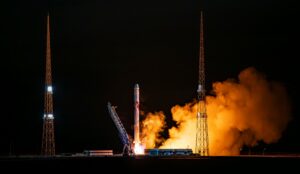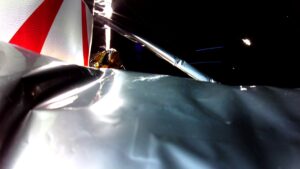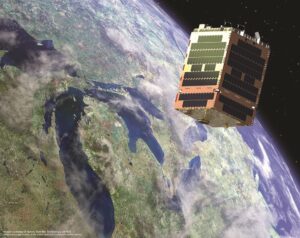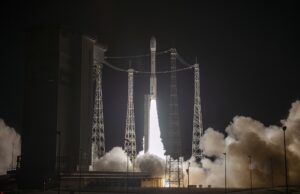
ORLANDO, Fla. — The United States risks taking a backseat in emerging space capabilities if regulations fail to catch up to industry progress, according to executives speaking here at the SpaceCom conference.
Federal agencies are taking great strides to modernize and streamline satellite licensing rules, CEOs of on-orbit refueling startup Orbit Fab and orbital surveillance venture True Anomaly said on a panel Jan. 31.
For instance, the National Oceanic and Atmospheric Administration now processes commercial remote sensing licenses in weeks instead of months.
But more needs to be done to support nascent space businesses, said Daniel Faber and Even Rogers, who lead Orbit Fab and True Anomaly, respectively.
Orbit Fab has not had a bad experience with regulators so far for enabling its three test missions to date, Faber said, “but then we haven’t tried to execute a full rendezvous, [proximity operations] and docking maneuver yet.
“But we’re looking at a situation where a Swiss company builds a spacecraft in the U.K. and wants to dock with a U.S. spacecraft,” Faber continued, which is running up against U.S. export restrictions under ITAR, or International Traffic and Arms Regulations.
“There’s an exception in the ITAR rules for collaborative docking for NASA’s interface because at the time that was written that was the only one that they could imagine, he said. “That was 20 years ago, so these kinds of things need to be reviewed.”
Proximity operations are part of a foundation that would enable space business in addition to on-orbit refueling, according to Faber, who said U.S. companies will be held back if regulations prevent them from cooperating with the rest of the world.
“There are people pushing business models for recycling and reuse of equipment” in space, he said, “and all these things are going to come and they’ve got to be enabled, or they’re going to happen outside the U.S.”
Defense needs
A speedy and modernized licensing regime is also critical for giving the United States capabilities to tackle emerging space threats, True Anomaly’s Rogers said on the same panel.
It is getting easier to hide capabilities in orbit that could pose threats to the United States and its allies, Rogers warned.
He called for a regime that can quickly license rendezvous and proximity satellites for taking precise high-resolution imagery of orbital objects — such as the spacecraft True Anomaly is plotting — to improve the integrity of space domain awareness efforts. The blurred lines between commercial and defense applications for these capabilities are complicating these efforts, Rogers noted.
Meanwhile, Faber hopes voluntarily publishing flight paths and exit plans in case something goes wrong during a rendezvous and docking mission will help smooth the way with regulators.
“And we want to be getting third parties to be monitoring that,” he said, “and in fact we’ll pay third parties to monitor that just to set a good precedent.”
The Federal Communications Commission released a draft Notice of Proposed Rulemaking (NPRM) Jan. 25 to set up a licensing framework for in-space servicing, assembly, and manufacturing activities.
If the NPRM passes an FCC vote Feb. 15, it will enter a public comment period lasting 45 days after publication in the Federal Register.
- SEO Powered Content & PR Distribution. Get Amplified Today.
- PlatoData.Network Vertical Generative Ai. Empower Yourself. Access Here.
- PlatoAiStream. Web3 Intelligence. Knowledge Amplified. Access Here.
- PlatoESG. Carbon, CleanTech, Energy, Environment, Solar, Waste Management. Access Here.
- PlatoHealth. Biotech and Clinical Trials Intelligence. Access Here.
- Source: https://spacenews.com/startups-call-for-streamlined-us-regulations-for-emerging-space-capabilities/
- :has
- :is
- :not
- :where
- $UP
- 15%
- 20
- 20 years
- 25
- 31
- 45
- a
- According
- activities
- addition
- administration
- After
- against
- agencies
- ago
- All
- also
- an
- and
- applications
- ARE
- arms
- AS
- Assembly
- At
- atmospheric
- awareness
- back
- Bad
- BE
- because
- between
- builds
- business
- businesses
- call
- called
- CAN
- capabilities
- case
- Catch
- CEOs
- collaborative
- come
- comment
- commercial
- commission
- Communications
- Companies
- company
- Conference
- continued
- cooperating
- could
- critical
- Daniel
- Date
- Days
- Defense
- Dock
- domain
- done
- during
- easier
- efforts
- emerging
- enable
- enabled
- enabling
- Enter
- Even
- exception
- execute
- executives
- Exit
- experience
- export
- fact
- FAIL
- far
- FCC
- Feb
- Federal
- Federal Communications Commission
- fla
- flight
- For
- Foundation
- Framework
- from
- full
- getting
- Giving
- Goes
- going
- good
- got
- great
- had
- happen
- he
- Held
- help
- here
- Hide
- high-resolution
- hopes
- HTTPS
- if
- imagine
- improve
- in
- industry
- instance
- instead
- integrity
- Interface
- International
- IT
- ITS
- Jan
- jpg
- just
- kinds
- lasting
- lead
- License
- licenses
- Licensing
- lines
- looking
- manufacturing
- Mission
- missions
- models
- modernize
- Monitor
- monitoring
- months
- more
- nascent
- National
- Need
- needs
- noted
- Notice..
- now
- objects
- of
- on
- ONE
- only
- Operations
- or
- Orbit
- outside
- panel
- part
- parties
- passes
- paths
- Pay
- People
- period
- plans
- plato
- Plato Data Intelligence
- PlatoData
- Precedent
- precise
- prevent
- processes
- Progress
- proposed
- public
- Publication
- Publishing
- Pushing
- quickly
- recycling
- Refueling
- regime
- register
- regulations
- Regulators
- released
- remote
- respectively
- REST
- restrictions
- reuse
- reviewed
- risks
- Rogers
- rules
- running
- s
- Said
- same
- satellite
- satellites
- servicing
- set
- situation
- smooth
- So
- so Far
- something
- Space
- spacecraft
- speaking
- startup
- Startups
- States
- streamline
- streamlined
- strides
- such
- support
- surveillance
- Swiss
- tackle
- taking
- test
- that
- The
- the world
- Them
- then
- These
- they
- things
- Third
- third parties
- threats
- three
- time
- to
- traffic
- tried
- true
- u.s.
- under
- United
- United States
- us
- venture
- voluntarily
- Vote
- want
- wants
- warned
- was
- Way..
- we
- which
- WHO
- will
- with
- world
- would
- written
- Wrong
- years
- yet
- zephyrnet









